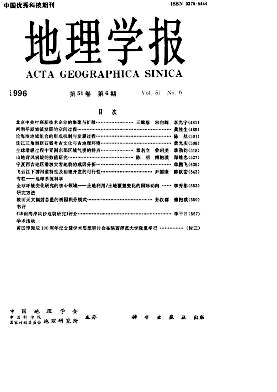Chen Yufeng, Li Kerang
In this paper, the micro-static model of climate-vegetation response in China based on soil classification is used. At present, the model has been programmed by Visual Basic 4.0 language and has been coupled with theGIS/ICCF system developed by the authors. On the support of GIS/ICCF, the changes in distribution of vegetationtype in China based on scenarios for 2×CO2 are studied.(1) The percentage change in the area of each type is relatively small, with the biggest negative change(3.68%) in no vegetation region and the biggest positive change (6.39%) occurs in the cold prata, which is basedon GISS produced scenario. However, as for the relative change of absolute area ailer CO2 concentration isdoubled, there are great difference between the increase and decrease in the area of each vegetation type. Theareas of such types as temperate deciduous broadleaf forest and shrub, subtropical and tropical mountainousconiferous forest, tropical broadleaf forest, cold prata, annually double harvested or biannually tripe harvestedcrops, annually single(double) harvested cold-demanding rice etc., tend to expand, while the areas of such typesas cold temperate and temperate mountainous coniferous forest, subtropical evergreen broadleaf and deciduousbroadleaf mixed forest and shrub, mountainous shrub, temperate desert, cold desert, temperate prata, temperateprata and marsh, annually single harvested crop, annually double harvested rice or warm-demanding dry cropaccompanied with rice tend to shrink.(2) Based on GFDL and GISS produced scenarios of doubled CO2, the lower limit of distribution ofsubtropical and tropical mountainous coniferous forests, tropical broadleaf forest etc., will slightly increase byabout 150m~350m and 280m~560m, respectively; the lower limit of distribution of temperate deciduous broadleafand shrub, mountainous shrub, annually double harvested rice or warm-demanding dry crop accompanied withrice and no vegetation region will decrease by about 60m~900m; the lower limit of distribution of other typesbasically keeps unchanged. Meanwhile, the upper limit of distribution of such types as temperate deciduousbroadleaf forest and shrub, temperate desert, annually single harvested irrigated and dry crops etc., will increaseby 100m~600m; the upper limit of distribution of such types as subtropical and tropical coniferous forests, andtropical broadleaf forest, will decrease by 100m~1000m; the upper of limit of distribution of other types basicallykeeps unchanged.(3) Four indices of eastern, western, southern and northern boundaries is used to describe the horizontaldistribution of vegetation types in China.(I) Based on various scenarios of doubles CO2, the changes in eastern boundary are similar. Except the typessuch as annually double harvested irrigated and dry crops will shift toward west by 4.6° longitude, the other typeswill extend toward east to some extents, among which temperate deciduous broadleafforest and shrub shift towardeast to the largest extent, by about 8°~9°longitude, cold temperate and temperate mountainous coniferousforested shift toward eaSt to the least extent, by only 0.5°~1°longitude.(II) On the average, based on GFDL produced scenario, the Western boundary of vegetation in China willshift towards west by 0.5°~12° longitude, with the average of about 3.6° longitude, based on GISS producedscenario. the western boundary of .vegetation will shift by 0.I°~12° longitude toward west. with the average ofabout 5.2° longitude: based on OSU produced scenario, the western boundary of vegetation will shift by about0.5°~5° longitude toward west, with the average of about 2.4° longitude.(III) The change in the southern boundary of vegetation in China. based on various scenarios produced byGCMs, are also similar. Due to doubled CO2, mountainous shrub. temperate desert, cold desert and temperategrassland will move toward south. The southern boundaries of other types will either keep unchanged or shrinkback toward north. In general, the range of extending toward south is mostly within 0.5-2.5
